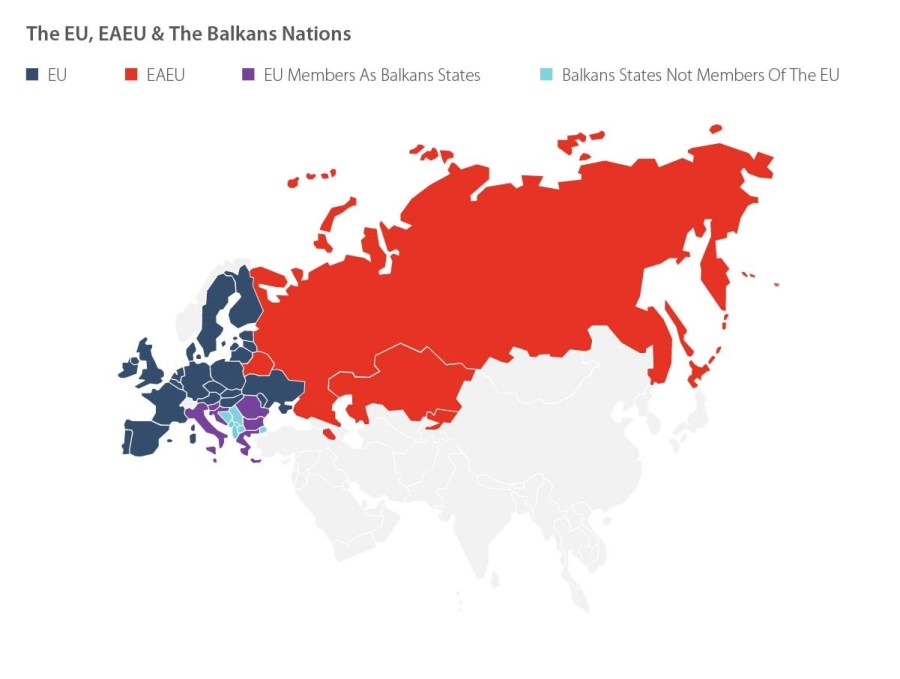Russia Invites Albania, North Macedonia To Join Eurasian Economic Union
Op/Ed by Chris Devonshire-Ellis
Eurasian Economic Union Competing With European Union For Members
Ten days ago, in the article A Comparison Of Countries In The Eurasian Economic Union With Those Who Aren’t I mentioned that both Albania and North Macedonia had been rebuffed by the European Union as regards their proposed membership negotiations.
I commented “With both Albania and North Macedonia having been spurned by the EU last week as concerns previously agreed deadlines for EU membership negotiations, Brussels is playing a dangerous game when it comes to keeping and then breaking promises. The Balkans are very much in Russia’s sphere of influence and it will be interesting to see if these two countries also opt for the Eurasian Economic Union as a viable trade bloc alternative instead, just as nearby Serbia has done.”
Today, the Albania Daily News reports that exactly this has occurred – Moscow has invited Albania and North Macedonia to join with the Eurasian Economic Union (EAEU). The invitation was made last Friday by Vladimir Chizhov, the Russian Permanent Representative of the EU during a meeting of the Eurasian Economic Forum in Verona, Italy. Chizhov stated that “I am sure that the countries, which are candidates for EU membership, and have recently been ‘put on ice’ by Brussels, will find understanding sooner in the Eurasian Economic Union than the EU.”
It remains to be seen what the response from Tirana and Skopje will be. In Tirana, the mood towards Brussels will probably be one of exasperation and frustration. Albania, neighboring Greece, first commenced steps to join the EU in 2000, and signed a “Stabilisation and Association Agreement” with Brussels in 2006. That was now thirteen years ago, and the country is still not in any free trade bloc and has just been put in deep freeze by Brussels – meaning Tirana has just wasted nearly 20 years of effort to join.
What is becoming increasingly clear is that the European Union’s foothold in Central and Eastern Europe is now becoming tenuous. China has established the CEEC 17+1, an informal bloc that includes Albania and North Macedonia along with China, Bosnia & Herzegovina, Bulgaria, Croatia, Czech Republic, Estonia, Greece, Hungary, Latvia, Lithuania, Montenegro, Poland, Romania, Serbia, Slovakia and Slovenia. It discusses trade, investment, infrastructure development and the development of the Belt & Road Initiative.
Of these countries, neither Albania nor Montenegro use the Euro as they are not members of the EU, but neither do the eastern EU member states Bulgaria, Croatia, Czech Republic, Hungary, Poland or Romania. This would make any reversal away from Brussels and towards the Eurasian Economic Union a lot easier to accomplish.
Concerning the Eurasian Economic Union, its attraction principally lies in its geographical position lying between the European Union and China. Members include Armenia, Belarus, Kazakhstan, Kyrgyzstan and Russia, however it also has Free Trade Agreements with China, Iran, Singapore, and Vietnam, while Serbia, another European country has also just joined. Moscow has also agreed to finance and help build the high-speed rail between Serbia and the Montenegran Port of Bar.
EAEU Free Trade discussions with numerous other Asian countries, such as India, Indonesia, & Thailand, as well as others in Africa are currently underway in markets that the EU has not fully incentivised its own members to take advantage of. In short, the EAEU has the potential to offers Russia, Central Asia, China, South-East Asia and African access in a manner and with trade potential that an increasingly expensive and argumentative EU cannot. The understanding of how this can happen, and how the developments in hand will pan out is a key issue when determining the full potential of the Eurasian bloc as an EU alternative.
Although the China-EAEU FTA in terms of products is still being worked out, Eastern European countries will be interested in joining a Free Trade bloc that includes the possibility of China access. At present the European Union does not have an FTA with China, has placed sanctions on Russia, and as a result is limiting Eastern Europe in its ability to trade on its eastern borders. Hungary’s Foreign Minister Peter Szijjarto for example recently estimated that EU sanctions on Russia has cost its economy €8 billion in lost trade revenues. Italy meanwhile, a G7 member recently shocked Brussels by opting to sign up with China’s Belt & Road Initiative, and has just hosted the latest Eurasian Economic Union forum.
Clearly, changes are happening, and are obviously progressing in terms of dialogue. The implications for the European Union, and especially Eastern Europe and the Balkans as to where their common destiny lies is currently an issue up for negotiation – with discussions being held right now. While the European Union appears disinterested in the region and has at present placed Albania and Northern Macedonia’s accession on ice – other parties are showing an active interest and with apparently viable alternative market options.
Related Reading
- Chinese Belt And Road Lobbying In The European Union
- How Russian Manufacturers Can Access China, India and The EU Markets Via The EAEU Free Trade Agreements
- Serbia To Become Route Between Eurasia & Europe As It Signs Off EAEU Free Trade Deal
About Us
Silk Road Development Weekly is compiled each week by Chris Devonshire-Ellis, Chairman of Dezan Shira & Associates. The firm has 28 offices throughout Eurasia and assists foreign investors into the region. For strategic advisory and business intelligence issues please contact the firm at silkroad@dezshira.com or visit www.dezshira.com






